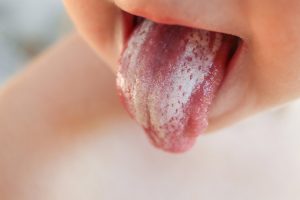
Oral thrush is a mycosis – a fungal infection – of the mouth which can seem pretty ugly when you first see it: creamy white patches on the tongue and cheeks, some blisters at the corners of the mouth and even occasional bleeding. All in all, it can look pretty scary if you don’t know what it is.
Of course you may think your baby’s in danger if they show any of those signs; however, you’ve got nothing to worry about: oral thrush is a very common condition in babies, and it may even go away without treatment. In this article, we’ll take a look at the most common causes and symptoms, and then we’ll discuss the best way to treat oral thrush in babies and toddlers.
Causes
 Roughly 1 in 7 babies will get oral thrush at some point before they turn 2, and most of them will get it before 10 weeks of age. Newborn babies are most likely to get oral thrush at birth, especially if the mother carries vaginal candida. If this happens, babies will show the first symptoms within ten days. However, not all babies get candida albicans at birth, and not all who do eventually develop thrush.
Roughly 1 in 7 babies will get oral thrush at some point before they turn 2, and most of them will get it before 10 weeks of age. Newborn babies are most likely to get oral thrush at birth, especially if the mother carries vaginal candida. If this happens, babies will show the first symptoms within ten days. However, not all babies get candida albicans at birth, and not all who do eventually develop thrush.
In fact, it’s not completely clear why babies develop thrush at all, since candida is often present in their mouth without causing any problems. However, candida in babies is definitely related to their underdeveloped immune systems.
Once babies develop thrush, they risk infecting their mothers, too. This will only happen if the children are breastfed, as they will be passing the yeast to their mothers’ nipples. If untreated, this will result in a back-and-forth transmission of the fungus, which will lead to chronic thrush. However, the treatment is painless and uncomplicated, so this re-transmission shouldn’t normally happen.
Just like adults, toddlers may also develop thrush if they’ve been treated with antibiotics. Such medication courses affect the healthy bacteria in the mouth and increase the number of candida albicans.
Symptoms
At first, the condition may go unnoticed. However, as the fungi grow, creamy white patches begin to appear. You’ll be able to tell them apart from any milk leftovers because they’ll cover not only the tongue, but the cheeks and the inner lips, too.
begin to appear. You’ll be able to tell them apart from any milk leftovers because they’ll cover not only the tongue, but the cheeks and the inner lips, too.
Apart from these lesions, babies may also be irritable and have difficulty feeding.
If the mother breastfeeds an infected baby, she’s likely to get thrush, too. Her mouth will be ok, obviously, but her nipples will get the condition. Common symptoms associated with this infection are red and sensitive nipples, shiny skin on the region around the nipples (the areola), deep pangs inside the breast and pain while breastfeeding.
Treatment
Oral thrush in babies may go away without treatment, if the infection is mild. This process usually takes just a few days. If the condition persists more than that, you should look for specialist help.
The most commonly prescribed treatment is either a gel containing miconazole, or drops containing nystatin.
Miconazole isn’t licensed for babies under 4 months, but doctors generally prescribe it regardless of age. It’s a gel that you smear on your baby’s mouth and tongue with your finger, paying attention not to go too deep inside the mouth. It’s best to apply the gel after feeding, so that it stays on the affected area long enough to kill the fungus.
Nystatin are drops that you should also apply directly on the infected region, following the doctor’s advice. This is usually prescribed as an alternative to miconazole.
Sometimes, your doctor may also prescribe fluconazole pills, in doses of 3-6 mg per kilogram. These are usually prescribed for babies over 4 weeks of age. This type of treatment is not very common, and it’s usually only necessary if miconazole or nystatin have been inefficient.
It’s important to know that any toys or feeding equipment may also carry candida albicans, so it’s best to sterilize those regularly.
Conclusion
Oral thrush is a common condition in babies, so you shouldn’t worry too much if your little one has it. While it will sometimes go away without treatment, using an anti-fungal gel or drops will treat the condition in due time. Remember to sterilize everything your baby’s mouth comes into contact with, so as to prevent repeated bouts of oral thrush.
Resources:
http://patient.info/health/oral-thrush-in-babies
http://www.medicalnewstoday.com/articles/179069.php
http://www.babycenter.com/0_thrush-in-babies_92.bc
http://www.netdoctor.co.uk/conditions/mouth-and-teeth/a3076/oral-thrush-fungal-infection-in-the-mouth/
http://www.rxlist.com/diflucan-drug/indications-dosage.htm

